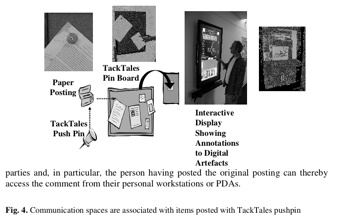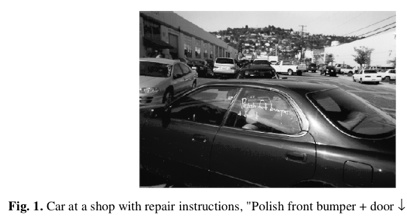Churchill, E. F., Nelson, L., and Sokoler, T. (2005). Tools that tell tales: Bridging context seams by digitally annotating physical artifacts. In Proceedings of the Workshop on Smart Object Systems In Conjunction with the Seventh International Conference on Ubiquitous Computing (UbiComp 2005), Tokyo, Japan. [pdf]
———-
The main argument of this paper is that instead of relating notes to a physical place, we should attach them to a physical object. This because the object is meaningful and seamless between the activity in which it is involved and the people that will be part of those activity. The paper reports the main rationale behind the prototype TackTales that augments a physical bullettin board with digital information.
In this paper we describe our method for supporting artifact-centered communication. We elaborate a design space we have been elaborating called Tools That Tell Tales, and describe the TackTales prototype which provides an instance in this design space. We show how paper postings on a community pin board can be augmented to enable conversations around the physical, paper postings. The TackTales prototype uses modified radio frequency identification (RFID) technology to establish the link between paper postings and the online communication, bridging a seam between artifacts and conversation and activity as annotation. We suggest that our approach can be a ubiquitous computing alternative to the design of general-purpose communication devices and propose artifact-centered communication as a meaningful conversational annotation.
The picture below shows one of the nice example contained in the paper. The car window itself is the communication space, being annotated with a wax marker, with explicit instructions on the collaborative repair process.


